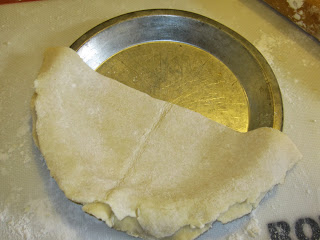One of my roommates in college shared this recipe with me. Most pie crust recipes don't call for the use of an egg. And with reason! Eggs are typically used as a binding agent. Since pie crusts are meant to be fall-apart-flaky, using an egg seems counterproductive. However, in this particular recipe, the egg will help bind the dough long enough for you to work with it--it's easier to roll out and doesn't crumble. But adding vinegar is the key to getting a flaky crust. The vinegar breaks down the protein in the egg, and it ceases to act as a binder. This gives you the best of both worlds! Dough that is easy to work with, crust that is tender and flaky when baked.
This recipe makes quite a bit, so you only have to make one batch for several pies. Alternatively, you can use part of the dough and freeze the rest for your next pie-making adventure.
The dough starts off a bit crumbly.
Roll it out on a floured surface, such as a clean kitchen counter or Roul'Pat.
To transport the rolled-out dough to a pie pan, I like to fold it in half or in quarters.
Put the folded dough in your pan and unfold.
Make sure your dough isn't stretched. You want room for filling, after all!
Next, trim the edges. You can do this with a sharp knife or kitchen scissors.
Save those scraps!
Once the edges are trimmed, you can flute them (pinch them to make a pretty border).
Make sure to cut vents in the top crust, and you're ready for the oven.
No-Fail Pie Crust
Recipe by Sara (stuff-by-sara.blogspot.com), lightly adapted from her college roommate
3 cups sifted flour
1 tsp salt
1 Tbsp sugar
1 ½ cups shortening or butter or some combination of the two (I prefer all butter)
1 egg, beaten
5 ½ Tbsp cold water
1 tsp vinegar
Combine flour, salt, and sugar. Cut in shortening and/or butter until mixture resembles coarse crumbs. Add water, vinegar, and egg. Toss together until moistened.
Refrigerate dough for 10 minutes or until you are ready to use it (no worries if you leave it in the fridge overnight).
Flour your counter top or other surface for rolling out your crust. Use a rolling pin to flatten dough to about ¼ inch thickness. If you need to re-roll your dough, be sure to stack or fold it, rather than just gathering it into a ball. This will help give your pie crust flaky layers.
Line pie plate with crust. Flute the edges.* Fill and bake according to recipe directions.
Makes 2 double pastry crusts.
 |
| flaky, buttery pie crust |













No comments:
Post a Comment